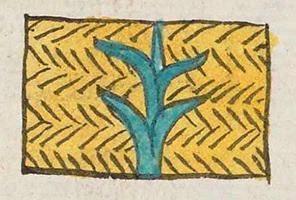Acapetlatlan (Mdz47r)
This compound glyph for the place name Acapetlatlan consists of two elements, a standing, vertical, turquoise reed (ācatl) plant contained or superimposed in front of a bird's eye view of a yellow, rectangular, hand-woven mat (petlatl). The locative suffix (-tlan) is not shown visually, but the gloss suggests -tlān (near) over -tlah (place of abundance of).
Stephanie Wood
The reed (ācatl) appears regularly in glyphs, both because it was a regular feature of the landscape, it was a substance used for thrones, and people slept on reed mats. It was also important because it served as both a day sign and a year sign in the calendar.
Stephanie Wood
acapetlatlan / puo
Acapetlatlan, pueblo
Stephanie Wood
c. 1541, but by 1553 at the latest
Stephanie Wood
reeds, plants, canes, mats, tules, carrizos, arrows, darts, xiuhpohualli

aca(tl), reed plant, https://nahuatl.wired-humanities.org/content/acatl
petla(tl), woven mat, https://nahuatl.wired-humanities.org/content/petlatl
-tlan (locative suffix), place, https://nahuatl.wired-humanities.org/content/tlan
-tlah (locative suffix), place of abundance of animal of thing, https://nahuatl.wired-humanities.org/content/tlah
"Reed-Mat Place" [Frances Karttunen, "Critique of glyph catalogue in Berdan and Anawalt edition of Codex Mendoza," unpublished manuscript.]
"Place of Many Reed Mats" (Berdan and Anawalt, 1992, vol. 1, p. 167)
Codex Mendoza, folio 47 recto, https://digital.bodleian.ox.ac.uk/objects/2fea788e-2aa2-4f08-b6d9-648c00..., image 104 of 188.
The Bodleian Libraries, University of Oxford, hold the original manuscript, the MS. Arch. Selden. A. 1. This image is published here under the UK Creative Commons, “Attribution-NonCommercial-ShareAlike 3.0 License” (CC-BY-NC-SA 3.0).


